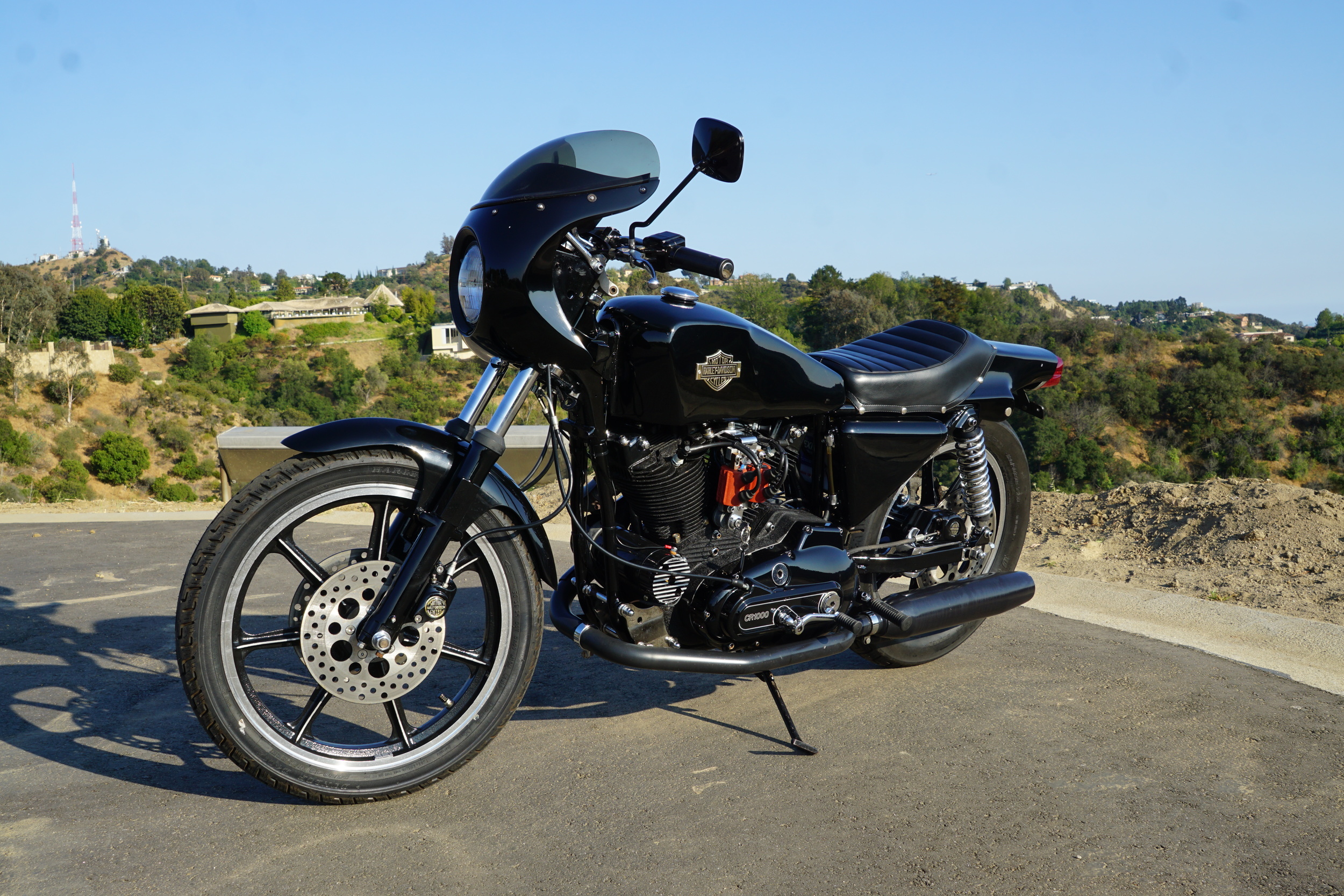Taking this bike out for a ride to shoot some photos of it was a absolute pleasure. Considering this is a 39 year old bike it rode so well and smooth. I guess I need to consider that there is less the 10k miles on it so it is relatively new even though it has been around for since 1977.
– 1977 Harley XLCR.. This is a very rare bike by Harley standards. This bike is Gorgeous and has to be seen in person to appreciate it. When Harley decided they wanted to go fast in the 70s this is what they built. Over 2k in maintenance in the last 6 months after the bike had been in a collection for some time and not run. Feature in American Iron Magazine in January 2010..
This particular bike features:
– New Tires
– Fluids changed
– Master cylinder front and rear flushed and new fluid
– All new charging system
– Rebuilt Carburetor
– New Battery
– Also comes with: extra tank badges, manual, and reflectors for from fork
The condition of the bike can best be classified as 8 out of 10 bike. It has a few blemishes but a extremely clean bike for its age. Mileage is 9940..
The XLCR was produced in three model years, 1977 (1900 units), 1978 (1200 units) and 1979 (fewer than 10 units left over from 1978 year). The all black steel tank and fiberglass tail piece coupled with the unique black siamese exhausts (1978 mufflers were larger than 1977) made the XLCR arguably the most attractive bike of it’s era. The “Cafe Racer” was the first Harley with triple disc brakes.
Some History
In an attempt to capitalize on the café-racing trend that was sweeping the country in the mid-1970s, Harley-Davidson ventured back into the world of customs to bring out the XLCR. Although the 1977 Harley-Davidson XLCR motorcycle was an attractive machine, competition from Japanese bikes was too fierce for the XLCR to be highly successful in the American marketplace.
It applied a small “bikini” fairing, skimpy front fender, angular fuel tank, solo seat with fiberglass tail section, triple disc brakes, and special “siamesed” two-into-two exhaust headers to a standard 1000-cc Sportster, and then cloaked the whole affair in black.
The problem was that although the XLCR was claimed to be “the most powerful production cycle Harley-Davidson has ever built,” that wasn’t saying much; Japanese competitors were quite a bit quicker and cheaper to boot.
Furthermore, the typical Harley buyer seemed to take little interest in joining the road-racing crowd, so sales never took off.
What was in fact a very interesting motorcycle (and quite soon, a very collectible motorcycle) faded
More details:
The Harley-Davidson XLCR1000 is unique in the range of models built by the famous Milwaukee, Wisconsin, company, in that it is definitely not built on the same ‘laid back’ lines as its tourer stable-mates. In fact the CR part of the title stands for Cafe Racer, and the Harley is unquestionably one of the most aggressive looking cafe racers available. Although outwardly different from the other Harleys, the XLCR still has the famous V-twin engine which, with very undersquare dimensions of 81 mm X968 mm, displaces 997-5cc.
A45degree unit, the engine features a 9:1 compression ratio, simple pushrod operated valves, a single 38 mm Keihin carburetor and all the reliability one could possibly need. Unsophisticated it may be, but the engine could pull a house down with its 68 bhp at 6200 rpm and, although undisclosed, probably around 60 lb ft of torque. Although the torque figure is not quoted by the company they do say that the ‘secret amount’ is produced at 3500 rpm, well down the rev scale but just the thing for instant acceleration in any of the XLCR’s four gears. An electric start is the only concession to modern times in the engine and it copes surprisingly well with getting the engine under way. Unlike a silky smooth Japanese multi, one is very well aware of when the Harley’s engine is running. It has an off-beat exhaust note, it rumbles and shakes and leaves the rider in no doubt as to its capabilities.
The engine, wet-multi-plate clutch and gearbox are mounted in a very narrow duplex frame to which is attached a rear end similar to the famous long-track Harley racers. Conventional springing is used, by courtesy of Showa of Japan, with neat alloy wheels built by Morris. Kelsey Hayes disc brakes are fitted all round. Lowered bars are fitted, there is a neat little windscreen, a 4gal fuel tank and a combined single-seat/rear fairing added to the machine, and just about everything is black, from the tinted wind screen and fairing to the matt-finish exhaust system. When first astride the XLCR one is aware that it is smaller than it looks as it weighs a trifling 485lb (low by Harley standards) and is as slim as a pencil. One’s hands are greeted by two enormous grips that feel seven sizes too big and one settles into the comfortable saddle, which is quite low at 30-5ins from the ground. Once the carb has been primed with the throttle and the carburetor-mounted choke lever pulled out, the engine will fire immediately and settle down to a 900 rpm idle. The clutch is extraordinarily heavy and the gearchange is vague, but once first has been selected one can rocket away from a standstill with the quarter mile coming up in just over 13secs.
There is really little point in taking the engine above 6000 rpm and even changing gear at 4000 rpm allows rapid progress. The bike’s top speed is really governed by its low gearing as the red line speed of just over 110 mph in top can be reached with no fuss at all. Vibration and a deafening roar are other factors that make approaching the red line of 6500 rpm of little value. With grippy Goodyear tyres and a long wheelbase, the Harley handles and corners well, with plenty of feel of the road being transmitted to the rider. In fact, on bumpy surfaces it would be fair to say that the ride can be quite jarring, but that is worth trading for a Harley that handles. Braking is ‘fair to middling’ in the dry, but just about non-existent in the wet, and waiting for the discs to work in the rain is hair-raising to say the least. On the other hand, the Goodyear A/T covers cope well in most conditions and the XLCR is a lot less of a handful than most of its stablemates on wet roads. FYI.. I did not write this,, but don't remember where I pulled this from a few weeks ago..






